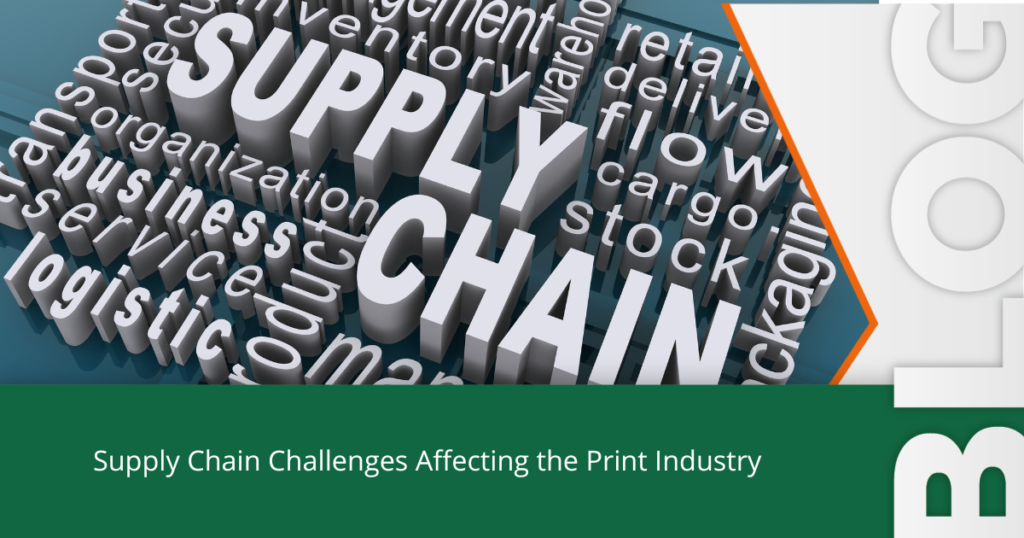Supply chain challenges have resulted in increased costs on major materials used by the printing industry.
During the height of the pandemic, there was a decrease in consumer demand which slowed production down. It also led to manufacturers laying off employees and reducing operations. The world then began to open back up and the global supply chain was not ready to meet the skyrocketing demand.
With limited supply and higher than usual demand, manufacturers have increased their prices. As a result, print companies are having to raise their prices and are facing interruptions in supply including major materials like ink, paper, printing supplies, and more.
We wanted to provide a glimpse into why certain pressures are affecting the supply chain – such as delivery time and cost due to price of fuel as an example. Below are several factors that have impact on your print jobs with Minuteman Press Calgary Shepard.
Prices
Inflation is all around us. Your favorite meal from your favorite fast-food restaurant is now more expensive than it was 12 months ago. The same thing is happening to the materials printers use to produce your projects. Paper, ink, binding material and more. Everything is now more expensive, and those prices will climb even more within the year.
Because of this, printers must possibly also increase the prices of their products so they can keep running their business smoothly. This may mean that a project you have ordered in the past with your printer may have a higher price now if you decide to reorder it. So, be sure to ask your printer about other options if the new prices do not match your budget.
Minuteman Press Calgary Shepard has done everything within our power to not let these supply chain challenges affect our pricing or service levels.
Theresa , Dennis, Raj, and entire Minuteman Press Calgary Shepard Team
Paper
Paper pricing is on the rise for many reasons. Canada Post changes, paper shortages, high demand for paper, and the increase in transportation costs are just a couple of the reasons paper is a leader in the supply chain challenges.
While many businesses were forced to shut down or slow down, there was a decrease in the need for marketing materials like catalogs, brochures, or even newspapers. Everyone was at home and shopping online. Now with many businesses back open, running, and eager to grow. Print marketing materials are in high demand, and the materials to produce them are scarce.
For commercial printers, the biggest issue for paper has been the need to increase their prices and the difficulty in finding specialty papers for custom orders. And if they can find them, they are taking longer to arrive and are priced higher than ever before.
While printers are being forced to raise their prices, it’s important to try and stay with your preferred printer’s standard paper options. This is because your printer regularly orders these paper stocks and stores them in-house, so they are always ready. Along with this, your printer’s standard or “preferred stocks” will always be cheaper than the specialty paper options.
Ink Products
Ink and toner have been impacted the same way paper has been. Increase in transportation costs, sporadic demand, and supply chain constraints have all played a role in the increased price of ink. In general, base inks or the typical vegetable-based inks that printers use every day and orders are beginning to experience delays. Specialty inks and coatings are becoming very scarce and more difficult to find. This means that when you order a custom product that involves specialty inks or coating like aqueous coatings, you will want to plan and place your order much earlier than you usually would to avoid any delays.
Keep in mind that planning and ordering early is a good practice for standard projects as well.
Staffing
We have all seen an increase in the number of “Now Hiring” signs posted on the outside of every other building we pass by. Staffing levels is another core cause of the overall supply chain challenges impacting the print industry.
The difficulty in finding new employees is not just hitting small businesses, it is hitting the mail carriers, paper mills, ink manufacturers, transportation services, and more. With a decrease in staffing and an increase in demand, delays are inevitable. In fact, just in Eastern Ontario, there was an audit that found more than 15 million pieces of mail were delayed last year because of staffing issues.
Turnaround Time
Orders have been coming in at a rapid speed due to trade shows and events being back up and running, more companies learning about the benefits of print and direct mail, and in general businesses just running their operations and marketing campaigns more normally compared to during the peak of the pandemic. Because of the influx of projects coming in – and so many of them as a “rush” – on top of the supply chain delays, printers often include flex days or padded days to give their production team enough time to accommodate these changes.
Planning early has always been a good idea. Now more than ever, it will ensure a successful print campaign to start earlier and pad the timeline to accommodate the supply chain challenges.
Shipping
The cost of gas compounds the past two years of uncertainty. As the cost of fuel rises, logistics companies are forced to raise prices or take losses. In turn, the cost of fuel does not only affect the logistics company, but also the shipper and the client. It is an outward domino effect. If the shipper is going to be charged more to transport the freight, the receiver is going to be charged more to make up for their added costs.
If your campaign with us is a Direct Mail campaign, we also need to keep a watch on Canada Post service levels and delivery schedules. Because Canada Post is a printer’s carrier and not part of the turnaround time, the only thing your printer can do is work hard to make sure the turnaround is what you need and help you track where your project is once it has left their facility.
Because of this, it is even more important to plan your print and mail campaigns earlier than normal to make sure your print project or direct mail materials arrive when you need them to and not later.
Production Supplies
Supplies used during production including cartons, banding materials, pallets and plastic wrap are all in short supply. This is because the manufacturers who printers receive these materials from are having trouble acquiring the raw materials, they need to produce these needed supplies.
Freight
There is an increase in shipping needs across every industry and with this increase, there is also a shortage of transportation trucks and drivers inevitably causing the reliability of deliveries arriving on time to decrease significantly.
Postscript: It’s all about turn-around time!
The more you plan for the worst-case scenario, the more likely your deadline can be met. Here are two ways to deal with this. First, plan early! Try to submit your purchase order at least one to two weeks before your files are ready, especially for larger runs or projects that involve a mailing component. That way, we can order the materials in advance, giving us a cushion if there is a shortage. Second, if you can, you should also build extra time into your expected delivery date. For example, if you normally expect a job to take two weeks from when you release the files, give yourself an extra week or so in the short term until this is all straightened out.
Although the supply chain challenges remain uncertain, proper planning will ensure that you get what you need on time. Save yourself the time and stress by thinking ahead, your future self will thank you!
Contact us today to start the conversation.

